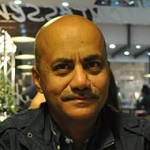Several years ago, an artist who was a writer as well defined his two occupations as such: ‘Art is my wife, I am married to it, thus bound to it; whil
Several years ago, an artist who was a writer as well defined his two occupations as such: ‘Art is my wife, I am married to it, thus bound to it; while writing is my mistress, so I take great pleasure in it and spend more time with it’. The description is unique explanation, and may not be politically correct one, but he was not alone in terms of individuals who have been expressing in more than one form of creative field. There have been examples of writers, who were painters as well, like D. H. Lawrence, Ram Kumar and Octavio Paz, and likewise several artists also contributed in the realm of fiction and poetry, such as Alfred Kubin, Anwar Jalal Shemza, Tassaduq Suhail and many others.
But this exchange does not take place among various areas/practitioners of creative expression, because often sportsmen, actors, physicians, scientists, lawyers – and even criminals and prisoners have a double life as an artist. It is not necessary that they have studied at an art school, because in order to excel in the filed of visual art, one does not require or depends upon academic training. Often that lack – rather, absence of formal education in art is the reason for adding new and exciting elements in to the existing art practices.
Perhaps these examples, in which grown up men and women having other/parallel and successful professions choose to pursue art, raise the basic question that why a person picks art in the first place. What are the motives, factors and fascinations which compel, instigate and inspire a human being – either a child or a mature individual, to explore the world of art; and how the other experiences of life are related to this activity of producing works of visual arts.
In Pakistan there is a different dimension to this general situation, because like in many other areas majority of people are not clear about their identities as professionals, and here one has to perform multiple (often contradictory) roles. Along with this certain personalities are not contained in one category, so there are a number of leading figures of one field, who are known for their diversity of interests and practices: Ranging from great scientist Dr Salimuzzaman to eminent Punjabi poet Najm Hosain Syed, seasoned politician Sardar Asseff Ahmed Ali, and including models, actors Ali Zafar, Ayesha Omer, banker Kamal Hayat and many others.
Art Now Pakistan is bringing this theme into focus, and by comparing the two aspects of aesthetic pursuits and professions, may a better understanding of creative phenomenon be achieved. Because like love, Art is not selected by a human being, it is the other way around, Art picks a person. These and other debates on the nature of art are explored in the section of In Focus, and both essays by Aasim Akhtar and Madyha Leghari, address these concerns and illustrate as well as analyse the nature of art making in diverse environment, situations and necessities. Complementing to the theme of month, photo-essay is created by a person, who is not formally trained in art, yet these images bridge this gap, much like as photography connects the real world to its virtual/visual representation/replication.
The profile of Anwar Maqsood and the interview of Naeem Pasha are ways of acknowledging and recognizing contributions in the field of visual arts by these figures, who are known for their other professions. Both texts attempt to understand the common link, between a person who moves form one discipline to other. Along with our regular news and exhibition reviews, this month’s book review of The Shape of the Pocket shares how art is not limited to studio or with brush and paint only, it transcend boundaries. Like the writer, John Berger, who has been a painter too besides being one of the most important and influential art critics of his times.
Thus the Other Strokes in Art Now Pakistan are not just daubs of different hues, but it surveys these multiple diversions and deviations, which compile a picture of art – but do not complete it.

Quddus Mirza
Editor

COMMENTS